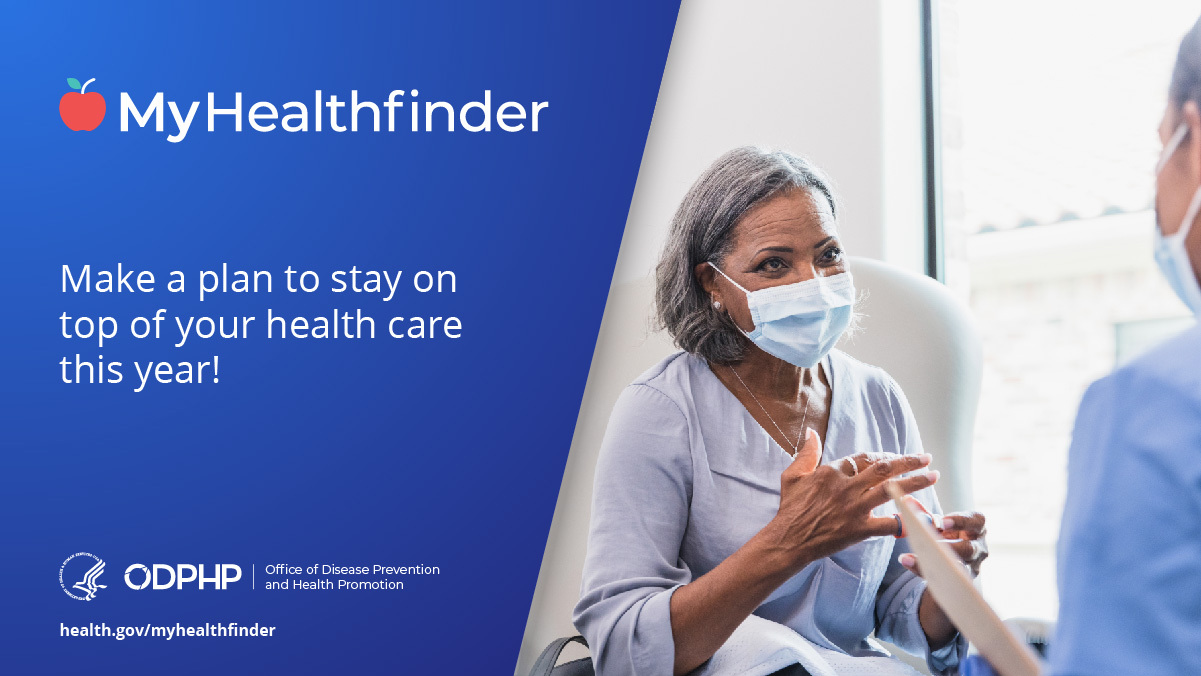At ODPHP, we encourage patients to use MyHealthfinder to learn about the preventive services they need to stay healthy. The COVID-19 pandemic has affected almost every part of our lives — and health care is no exception. In the past year, many people may have put off routine health care and preventive services like screenings and vaccines because they’re worried about getting COVID-19. But doctors warn that this could cause problems in the future.
“This is a problem since a lot of conditions are harder to treat when they’re caught later on,” says Alex Krist, MD, MPH, a primary care physician at Fairfax Family Practice in Virginia. “Delaying some services for a couple months made sense early in the pandemic. But now delays are getting longer, which is a concern,” he says.
Dina Gottesman, MD, FAAP, a pediatrician at South Riding Pediatrics in Virginia, echoes these concerns. “These delays can lead to more complicated treatments (including surgeries), longer hospital stays, and a higher risk of complications,” she says.
Taking Steps to Keep Patients Safe
To make sure people keep their health care on track, many practices have made changes to keep people safe when they come for in-person care.
Kate Menard, MD, MPH, an obstetrician and professor at University of North Carolina School of Medicine, says her office has implemented a range of safety measures. All staff are screened for COVID-19 symptoms daily, before coming to work. At work they must wear face coverings, including eyewear. Staff are also tested for COVID-19 upon request.
Her office has also rearranged waiting areas, exam rooms, and workspaces to make more space for social distancing. In addition, patients are limited to bringing 1 support person to appointments. And since an important component of prenatal care is monitoring blood pressure, Menard’s office gives monitors to patients and explains how to use them. That way, patients can track their blood pressure at home.
Crystal Mayers, who manages Fairfax Family Practice, says that at the beginning of the pandemic they held all their appointments virtually because they didn’t have access to personal protective equipment (PPE) and needed to keep staff and patients safe. Since then, they’ve balanced in-person appointments with virtual visits to make sure there aren’t too many people in the office at a time — and to give staff more time to clean the waiting and exam rooms between patients.
Mark Ryan, MD, Medical Director at Virginia Commonwealth University’s Hayes E. Willis Health Center, adds that many preventive services (like vaccines and mammograms) can happen during short, in-person appointments — so that patients don’t have to spend as much time in the office.
Using Telehealth to Reach More Patients
Even with new policies to keep people safe, some people are still avoiding the doctor’s office — so practices are relying more on telehealth to reach them.
Menard says that her practice switched about 1 in every 3 prenatal visits to telehealth appointments when appropriate. Additionally, doctors now often explain patients’ imaging results (like ultrasounds) during telehealth visits, which frees up space in the office for appointments that need to happen in person. According to Menard, both patients and providers have given positive feedback about changes that help limit potential exposure to COVID-19.
Ryan adds that using telehealth more has other benefits, too. For example, it can help address barriers to getting care, like lack of transportation. In fact, no-show rates at his practice have actually dropped by more than half over the course of the pandemic.
Getting Back on Track
It’s normal for people to have concerns about getting in-person health care during the pandemic. Providers can help address those concerns by figuring out why patients are skipping their care and encouraging their patients to use MyHealthfinder to see which preventive services they need to catch up on.
“If I identify a woman who’s missing her prenatal visits, I try to explore the barriers she’s experiencing with her,” Menard says. “I try to understand her priorities and what motivates her, then make suggestions from that perspective that can help improve adherence to care.”
Gottesman adds that getting preventive services on time is especially important for babies and kids. This is because pediatricians use regular well-child visits to monitor their growth, help them manage chronic (long-term) conditions, and give them vaccines. And that way the doctor can help catch any problems early, when they may be easier to treat.
Ryan says that if patients have missed preventive services, the most important step is to contact their doctor’s office and schedule a visit to catch up on their health care.
“No need to carry any regrets for not having done things sooner,” he says. “The key step will be to get everything back on track.”
Disclaimer: This blog highlights the views of independent non-federal health care providers. ODPHP does not direct or endorse these health care providers.




